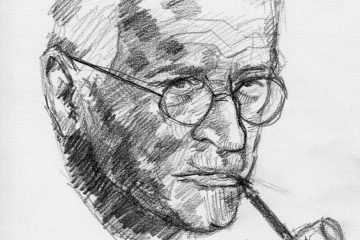
To listen to this article, click below:
Psychodynamic therapy
Psychodynamic therapy is a form of psychotherapy that aims to help people understand and resolve their unconscious conflicts, emotions, and motivations. This therapy is based on the psychodynamic theory a therapeutic theory where our behaviour and mental health are influenced by our early childhood experiences, our relationships with others, and our inner drives and desires. Transcendence is a concept that refers to the ability to go beyond the limits of ordinary experience and reality. Transcendence can be achieved through various means, such as meditation, spirituality, art, or nature. It can also be a goal of psychodynamic therapy, as it can help people overcome their psychological barriers and access a deeper sense of meaning and purpose in life.
Psychodynamic therapy and transcendence can work together in several ways. One way is that psychodynamic therapy can help us access and integrate our transcendent experiences into our sense of self and identity. For example, if we have had a spiritual awakening or a profound artistic inspiration, psychodynamic therapy can help us explore how this experience relates to our past, present, and future goals and values.
Another way is that psychodynamic therapy can facilitate transcendence by helping us overcome the barriers that prevent us from reaching our full potential. For example, if we have unresolved trauma, guilt, or shame that holds us back from pursuing our dreams or expressing our true selves, psychodynamic therapy can help us heal these wounds and free ourselves from their negative influence. A third way is that psychodynamic therapy can enhance transcendence by helping us cultivate a deeper and more authentic relationship with ourselves and others. For example, if we have difficulties trusting, communicating, or empathizing with others, psychodynamic therapy can help us understand the origins of these difficulties and develop more satisfying and meaningful connections.
Psychodynamic therapy in action
Psychodynamic therapy and transcendence can be put into action by using various techniques that aim to access the unconscious mind and foster a sense of connection with oneself and others. Some of these techniques include:
- Free association: This is a technique where the patient is encouraged to talk freely about whatever is on their mind and how they are feeling at that moment during the therapy session. The therapist listens attentively and tries to identify patterns of present behaviour and feelings related to past-experiences.
- Transference: This is a phenomenon where the patient unconsciously transfers feelings and attitudes from a person or situation in their past to the therapist or the therapeutic relationship. The therapist helps the patient recognize and work through these feelings and understand how they affect their current relationships.
- Interpretation: This is a technique where the therapist offers insights and explanations about the patient’s thoughts, feelings, behaviours, and conflicts based on their observations and understanding of the patient’s unconscious processes. The therapist helps the patient make sense of their experiences and gain new perspectives.
- Dream analysis: This is a technique where the patient shares their dreams with the therapist, and together they explore the meanings and symbols of the dreams. The therapist helps the patient uncover hidden messages and emotions from their unconscious mind that may be relevant to their current issues.
- Transpersonal techniques: These are techniques that aim to facilitate transcendence by inducing altered states of consciousness or enhancing spiritual awareness. Some examples of these techniques are meditation, hypnosis, holotropic breath work, and psychedelic-assisted therapy.
Example use cases
Some examples of people who have used psychodynamic therapy to achieve self-transcendence are:
- A woman who suffered from low self-esteem and depression due to childhood abuse. Through psychodynamic therapy, she was able to understand how her past-experiences influenced her current beliefs and emotions, and how she projected them onto others through transference. She learned to accept herself and forgive her abusers, and developed a sense of compassion and connection with others who had similar struggles.
- A man who struggled with addiction and anger issues due to unresolved trauma. Through psychodynamic therapy, he was able to explore his unconscious motives and conflicts, and how they drove his destructive behaviours. He learned to cope with his negative feelings in healthier ways, and to recognize his strengths and values. He developed a sense of purpose and direction in his life, and became more involved in his community and social causes.
- A couple who had communication and intimacy problems due to attachment issues. Through psychodynamic therapy, they were able to examine how their early relationships with their parents shaped their expectations and patterns of relating to each other. They learned to express their needs and feelings more openly and honestly, and to listen and empathize with each other more effectively. They developed a deeper bond and trust with each other, and a greater appreciation for their differences and similarities.
How a psychodynamic therapy session flows
A typical psychodynamic therapy session would involve the following steps:
- The therapist and the client establish a rapport and a therapeutic alliance, based on trust, respect and empathy.
- The therapist invites the client to share their thoughts and feelings about their current situation, problems and goals.
- The therapist listens attentively and actively, using techniques such as reflection, clarification and interpretation to help the client gain insight into their unconscious motives, conflicts and defences.
- The therapist helps the client explore how their past-experiences, especially their early childhood relationships, have shaped their personality, beliefs and behaviours.
- The therapist encourages the client to identify and express their emotions, especially those that have been repressed or denied.
- The therapist supports the client in developing healthier coping skills and strategies to deal with their challenges and achieve their goals.
- The therapist and the client review the progress and outcomes of the therapy, and discuss any issues or concerns that may arise during or after the therapy.
Further reading
If you are interested in learning more about psychodynamic therapy and its use in transcendence, here are some weblinks for further reading:
The Psychoanalytic Theory of Transference in Therapy: https://www.verywellmind.com/transference-2671660
Transference – Psychodynamic Psychotherapy: https://onlinelibrary.wiley.com/doi/pdf/10.1002/9781119142010.ch21
Psychodynamic Therapy and spirituality: https://www.icsw.edu/icsw_blog/psychodynamic-therapy-and-spirituality
Core Principles of Psychodynamic Therapy Approach: https://www.goodtherapy.org/learn-about-therapy/types/psychodynamic
Exploration of the patient-therapist relationship in psychotherapy: https://pubmed.ncbi.nlm.nih.gov/25017093/




0 Comments